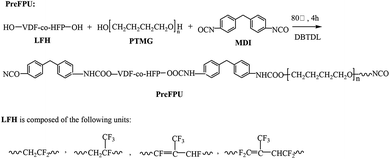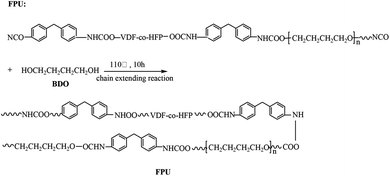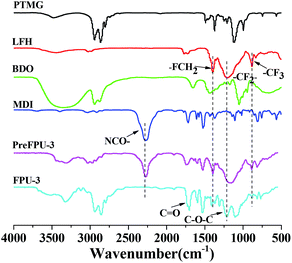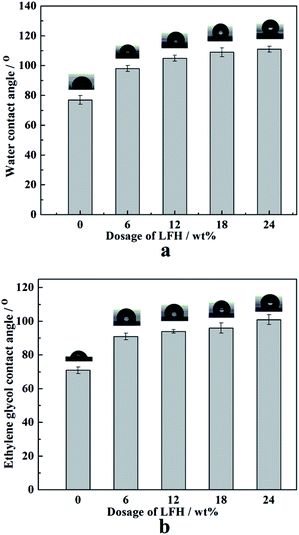 Open Access Article
Open Access ArticleCreative Commons Attribution 3.0 Unported Licence
Fluorinated polyurethane based on liquid fluorine elastomer (LFH) synthesis via two-step method: the critical value of thermal resistance and mechanical properties
Ning Li a,
Fanglei Zeng
a,
Fanglei Zeng b,
Yu Wanga,
Dezhi Qua,
Wenbo Hua,
Yigang Luanc,
Shuai Dongc,
Jianjun Zhangd and
Yongping Bai*a
b,
Yu Wanga,
Dezhi Qua,
Wenbo Hua,
Yigang Luanc,
Shuai Dongc,
Jianjun Zhangd and
Yongping Bai*a
aSchool of Chemistry and Chemical Engineering, Harbin Institute of Technology, Harbin 150001, China. E-mail: baifengbai@hit.edu.cn
bSchool of Materials Science & Engineering, Beijing Institute of Technology, Beijing 100081, China
cCollege of Materials Science and Engineering, Key Laboratory of Carbon Fiber and Functional Polymers of Ministry of Education, Beijing University of Chemical Technology, Beijing 100029, China
dFoShan NanHai Gotop Packaging Material Co., Ltd, Foshan 528225, China
First published on 15th June 2017
Abstract
Until now, only few hydroxy-terminated fluorinated monomers were reported as soft segment. In this work, based on a novel hydroxy-terminated liquid fluorine elastomer (LFH), a series of FPUs were synthesized via a two-step method. Flexible soft segment polytetrahydrofuran glycol (PTMG) was applied as the second soft segment. FTIR and GPC results indicated that the fluorinated groups were introduced into the structures of copolymers, and all the monomers were copolymerized successfully. TGA, DMTA and conventional mechanical analysis show that FPU gains optimal thermal stability and mechanical properties when the dosage of LFH is increased to a critical value of 18 wt%, even after the cured films being immersed into hot water and oil. Additionally, the surface properties of FPUs can be highly changed as a small amount of fluoride (6 wt%) is introduced into the structures of copolymers, due to the effect of fluorine enrichment. Consequently, LFH can effectively improve the thermal stability, mechanical properties, water resistance and organic solvent resistance of polyurethane within limits. Besides, these mentioned controllable properties of FPU can be achieved by changing the dosage of LFH. This work will help to achieve the best balance between performance and cost in industrial production.
Introduction
Fluorinated polyurethanes (FPUs)1,2 are a class of polymer materials with outstanding properties. Owing to the high electronegativity and small atomic radius of fluorine atoms, and the short C–F bond length, FPUs not only possess outstanding mechanical properties and two-phase microstructure from polyurethane,3–5 but also own the virtues of fluoropolymers, such as low surface energy, hydrophobicity, lipophobicity and high thermal stability.6–12 Accordingly, FPUs have aroused wide attention of researchers around the world since Lovelace firstly synthesized fluorinated polyurethane in 1958 via the reaction between isocyanate and fluorinated glycol.13 Until now, the fluorinated monomers such as fluorinated diisocyanate,14 glycol,15 polyether glycol,16–19 chain extender,20–24 side group25 and end-capper26 could all be used to synthesize FPUs. Consequently, FPUs have great application prospects in the areas of protective coatings, the paint industry, leather decoration and medicine.27–31However, until now, only a few kinds of hydroxy-terminated fluorinated monomers were reported, and even fewer of them could balance the benefit and performance of FPUs. “HO-VDF-co-HFP-OH” (LFH) is a kind of hydroxyl terminated poly(vinylidene fluoride–hexafluoropropylene) (VDF = vinylidene fluoride, HFP = hexafluoropropylene). It is a kind of hydroxyl terminated liquid fluorine elastomer with low molecular weight prepared in our laboratory. As one of reactants, it not only inherits some characteristics of solid-state fluorine rubber, such as low surface energy, high chemical stability and water resistance,32–35 but also remedies the defects of the solid-state fluorine rubber in mobility, sampling convenience and processing. LFH with active group-terminated can be introduced to FPU as the second soft segments, which could realize the controllable property of FPUs by adjusting the ratio of two soft segments. This new kind of FPUs and the critical value of the ratio between the soft segments have not been reported, which could be regarded as the “shining point” of this paper.
In this paper, a series of fluorinated polyurethanes (FPUs) were synthesized via a two-step method. 4,4-Diphenylmethane diisocyanate (MDI) and 1,4-butylene glycol (BDO) were applied as hard segments, two polyester polyols (hydroxy-terminated liquid fluorine elastomer (LFH) and polytetrahydrofuran glycol (PTMG)) were used as soft segments, dibutyltin dilaurate (DBTEL) was used as catalyst. The obtained FPUs were characterized by GPC, FTIR, NMR. TGA, dynamic mechanical analysis (DMTA) and conventional mechanic analysis showed that FPUs gained optimal thermal stability and mechanical property when the dosage of LFH increased to a critical value (18 wt%), even after the cured films being immersed into hot water and oil. Besides, the surface property of FPUs can be reduced rapidly once a small amount of fluoride is introduced, due to the effect of fluorine enrichment. Consequently, LFH can effectively improve the thermal stability, mechanical property, water and organic solvent resistance of polyurethane within limits (the dosage of LFH is between 6 and 18 wt%) and the controllable properties of FPU can be achieved via changing the dosage of LFH. It is highly beneficial to reduce the cost of the product based on these kind of FPUs.
Experimental section
Materials
Carboxyl-terminated liquid fluoropolymer (HOOC-VDF-co-HFP-COOH) was prepared as the previous report.36 Polytetrahydrofuran glycol (PTMG, Mw = 2050, Mw/Mn = 1.21) was obtained from Jining Hua Kai Resin co., Ltd. Sodium borohydride (NaBH4) and iodine (I2) was obtained from GuoYao Chemical Reagent Co., Ltd. 4,4-Diphenylmethane diisocyanate (MDI) was supplied by Bayer Industrial Corporation. 1,4-Butylene glycol (BDO) and ethyl acetate were provided by Beijing Chemical Plant. Dibutyltin dilaurate (DBTDL) was purchased from Tianjin Fu Chen Chemical Co., Ltd. PTMG was dried in a vacuum oven at 50 °C for 2 h.Synthesis of LFH
Hydroxyl-terminated liquid fluorine elastomer “HO-VDF-co-HFP-OH” (LFH) was prepared through reduction reaction of carboxyl-terminated liquid fluoropolymers as shown in Scheme 1. The dry THF (10 mL) solution with iodine (5.00 mmol) was added dropwise to the stirred dry THF (20 mL) solution with NaBH4 (10.00 mmol) under argon at 0 °C over 45 min. Then, the dry THF (100 mL) solution with carboxyl-terminated liquid fluoropolymers (10.00 g, 3.85 mmol carboxyl group) was added the above solution, and reacted at 70 °C for 5 min. After that, the mixture solution was cooled to 0 °C, and the excess hydride was carefully destroyed by dropwise addition of 2 mol L−1 hydrochloric acid (10.00 mL). After filtering to separate the complex of residual hydride and then excess deionized water was added into the filtrate. The mixture was extracted with THF for 3 times and the organic layer was collected. The solution was dried with magnesium sulfate. The resultant product was concentrated by a rotary evaporator. A viscous yellow liquid was obtained in a yield of 93%. Mw of LFH is 2400, PDI = 1.56 (estimated by gel permeation chromatograph (GPC) in THF on the basis of polystyrene calibration). | ||
| Scheme 1 The synthesis route of hydroxyl terminated liquid fluorine elastomer “HO-VDF-co-HFP-OH” (LFH). | ||
Synthesis of PreFPU
FPUs were synthesized via a two-step method. Scheme 2 shows the synthesis route of fluorinated polyurethane prepolymer (PreFPU). In this work, ordinary polyurethane (FPU-1) and four fluorinated polyurethanes (FPU-2, FPU-3, FPU-4, FPU-5) were successfully synthesized, the dosages of LFH in these FPUs are 0 wt%, 6 wt%, 12 wt%, 18 wt%, and 24 wt%, respectively. The process of synthesis of FPU-3 (18 wt%) was illustrated in detail below as an example. MDI (6.08 g) was added into a round bottomed flask equipped with condenser pipe and stirring system under nitrogen atmosphere. The flask was heated to 50 °C and maintained the temperature for 1 h to remove the water in MDI. PTMG (10.60 g) and LFH (3.70 g) were dried in a vacuum oven at 50 °C for 2 h and dissolved into ethyl acetate (20 mL). Then, DBTDL (0.15 g) was added into the above the solution. The mixture solution was stirred at the stirring speed of 150 rpm. After feeding raw material, the stirring speed was increased to 250 rpm. After reacting at 80 °C for 4 h, the reaction equipment was cool down to room temperature. Finally, the yellow viscous product PreFPU was obtained.Synthesis of FPU
The synthesis route of fluorinated polyurethane (FPU) is showed in Scheme 3. BDO (5.00 g) was added to the prepared PreFPU in the round bottomed flask, and stirred at the speed of 250 rpm for about 2 min. Then, the mixture was poured onto the treated mold, and put horizontally in a vacuum oven for 40 min, and dried at 110 °C in ordinary pressure environment for 10 h. Finally, FPU-3 film was obtained. Elemental analysis calculated (%) for FPU-3: C, 40.74; H, 5.73. Found (%): C, 40.11; H, 5.39.FPU-1 (0 wt%) was prepared via the similar procedure of FPU-3, the difference is that LFH was not be added into the reaction system.
Synthesis of FPU
The synthesis route of fluorinated polyurethane (FPU) is showed in Scheme 3. BDO (5.00 g) was added to the prepared PreFPU in the round bottomed flask, and stirred at the speed of 250 rpm for about 2 min. Then, the mixture was poured onto the treated mold, and put horizontally in a vacuum oven for 40 min, and dried at 110 °C in ordinary pressure environment for 10 h. Finally, FPU-3 film was obtained. Elemental analysis calculated (%) for FPU-3: C, 40.74; H, 5.73. Found (%): C, 40.11; H, 5.39.FPU-1 (0 wt%) was prepared via the similar procedure of FPU-3, the difference is that LFH was not be added into the reaction system.
Characterization
Fourier transform infrared spectroscopy (FTIR) measurements were performed using a Nicolet Nexus 670 instrument, USA. Molecular weights (Mw and Mn) and polydispersity indexes (PDI) of the polymers were estimated by a Waters gel permeation chromatography (GPC) system (Waters, 515 HPLC Pump) using THF as an eluent on the basis of polystyrene calibration and refractive index (RI) detector. Tensile strength and elongation at break were tested as a Chinese Standard (GBT 528-2009) using an RGT-5 electronic universal testing machine manufactured by Shenzhen Reger Instrument Co., Ltd. Hardness was tested by Shore Hardness tester as a Chinese Standard (GBT 531-1999). Thermal stability of the polymer was verified by a Perkin-Elmer TGS-2 analyzer using 1.5 mg of the sample in Al2O3 crucible under nitrogen ambience at a heating rate of 20 °C min−1. Dynamic mechanical thermal analysis (DMTA) was carried out on a dynamic thermal mechanical analyzer manufactured by DMA Q-800 (American Rheometric Scientific Company). Melting point (Tm) of FPU was investigated via differential scanning calorimetry (DSC) with a heating rate of 10 °C min−1 and in the temperature range from 50 to 250 °C, using DSC882e (METTLER-TOLEDO Co., Ltd.). Elemental analysis (C, H) was performed with a Perkin-Elemer 2400 II Elemental Analyzer. The viscoelastic behavior of FPU was investigated at a frequency of 1 Hz, strain 0.02%, with a heating rate of 5 °C min−1 and in the temperature range from −150 to 150 °C. The measurements were performed on rectangular specimens (15.0 mm × 7.0 mm × 1.0 mm ± 0.2 mm), under stretch mode, using stretch fixture (rectangle) geometry. The static contact angle of FPU films were measured by the sessile drop method at 25 °C using a Cam 200 optical contact angle meter (Dataphysics Instruments Co., Ltd.). Distilled water and ethylene glycol were used in the measurement. Typically, five angle measurements were made and the data were averaged. Chemical resistance of FPU film was characterized according to ASTM D471-02. The FPU films were immersed in the media (cyclohexane, 37% HCl and 45% NaOH, respectively) at a room temperature for 168 h and water of 90 °C for 48 hours. The weight change of the films was calculated by using the following equation:| Weight change (%) = [(W2 − W1)/W1] × 100, | (1) |
Results and discussion
1H-NMR and 19F-NMR analysis of LFH
The structures of the hydroxyl terminated liquid fluorine elastomer (LFH) and the precursor-carboxyl terminated liquid fluorine elastomer (LFE) were confirmed by 1H spectroscopy in Fig. 1a. Compared with LFE, LFH exhibits a new peaks at 3.6 ppm ascribed to the connected –CH2 group, which confirms the formation of LFH.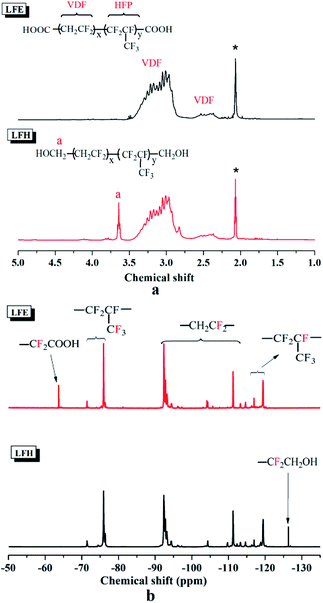 | ||
| Fig. 1 1H NMR (a) and 19F NMR (b) spectra of hydroxyl terminated liquid fluorine elastomer (LFH) and its precursor LFE in acetone-d6. The solvent peaks are marked with asterisks. | ||
To further characterize LFH, 19F NMR spectroscopy also is an effective method. The 19F NMR spectra of LFH and LFE can be found in Fig. 1b. For LFE, multiple broad peak at δ = −63 to −64 ppm, −71 to −77 ppm, −94 to −116 ppm, −116 to 120 ppm ascribes to the groups of –CF2COOH–CF2CF(CF3)–, –CH2CF2– and –CF2CF(CF3)–,36,40,41 respectively. And the curve of LFH exhibits a new peak at −125 to −127 ppm, it ascribes to chemical shift of F atom of –CF2CH2OH. All above confirm the successful formation of hydroxyl-terminated liquid fluoropolymer (LFH).
Analysis of FPU
The FTIR spectrum of fluorinated polyurethane (FPU) was showed in Fig. 2. Meanwhile, the spectra of polytetrahydrofuran glycol (PTMG), hydroxy-terminated liquid fluorine elastomer (LFH), 1,4-butylene glycol (BDO) and 4,4-diphenylmethane diisocyanate (MDI) were also given in the same figure for comparison. For FPU, the urethane N–H stretch absorption peak around 3340 cm−1, the –C–O–C peak at 1261 cm−1 and the strong urethane C![[double bond, length as m-dash]](https://www.rsc.org/images/entities/char_e001.gif) O peak around 1735 cm−1 prove the existence of –NHCOO–. Moreover, the strong absorption peaks at 884, 1210, and 1400 cm−1 are ascribed to the stretching vibration of –CF3, CF2– and –FCH2, respectively. And the same peaks also exist both in the FTIR spectra of the precursor LFH and PreFPU, which clearly demonstrate that fluorinated polyurethane have the same backbone structure as its precursor LFH. These new peaks indicate that the expected fluorinated polyurethane (FPU) has been successfully prepared. Additionally, the absorption peak at 2275 cm−1 (–NCO) disappear, indicating that the polyreaction has been consumed completely. And there was not unreacted prepolymer residue which could be confirmed by utilizing the “Chemical titration” method.42–45 Elemental analysis calculated (%) for FPU-3: C, 31.29; H, 7.05. Found (%): C, 31.26; H, 7.02.
O peak around 1735 cm−1 prove the existence of –NHCOO–. Moreover, the strong absorption peaks at 884, 1210, and 1400 cm−1 are ascribed to the stretching vibration of –CF3, CF2– and –FCH2, respectively. And the same peaks also exist both in the FTIR spectra of the precursor LFH and PreFPU, which clearly demonstrate that fluorinated polyurethane have the same backbone structure as its precursor LFH. These new peaks indicate that the expected fluorinated polyurethane (FPU) has been successfully prepared. Additionally, the absorption peak at 2275 cm−1 (–NCO) disappear, indicating that the polyreaction has been consumed completely. And there was not unreacted prepolymer residue which could be confirmed by utilizing the “Chemical titration” method.42–45 Elemental analysis calculated (%) for FPU-3: C, 31.29; H, 7.05. Found (%): C, 31.26; H, 7.02.
The comparisons of molecular weight (Mw) and PDI (Mw/Mn) of fluorinated polyurethane prepolymer (PreFPU) and fluorinated polyurethane (FPU) were presented in Table 1. Compared with PreFPUs, the molecular weight of FPUs increased hugely, which indicated that polyreaction of FPUs were processed successfully.
| Dosage of LFH | 0 wt% | 6 wt% | 12 wt% | 18 wt% | 24 wt% |
|---|---|---|---|---|---|
| a Mw of LFH is 2400. Estimated by gel permeation chromatograph (GPC) in THF on the basis of polystyrene calibration. | |||||
| Mw (PreFPU) | 4573 | 5650 | 6320 | 6164 | 6211 |
| PDI (PreFPU) | 1.25 | 1.33 | 1.31 | 1.29 | 1.37 |
| Mw (FPU) | 19![[thin space (1/6-em)]](https://www.rsc.org/images/entities/char_2009.gif) 932 932 |
43![[thin space (1/6-em)]](https://www.rsc.org/images/entities/char_2009.gif) 176 176 |
399![[thin space (1/6-em)]](https://www.rsc.org/images/entities/char_2009.gif) 087 087 |
41![[thin space (1/6-em)]](https://www.rsc.org/images/entities/char_2009.gif) 121 121 |
42![[thin space (1/6-em)]](https://www.rsc.org/images/entities/char_2009.gif) 348 348 |
| PDI (FPU) | 1.76 | 1.79 | 1.81 | 1.76 | 1.91 |
Thermal resistance property
Thermal gravimetric analysis (TGA) technique was utilized to study the thermal resistance of the FPUs. The TGA curves of the polyurethanes (FPU-1, FPU-2, FPU-3, FPU-4 and FPU-5) are showed in Fig. 3. In order to evaluate the initial decomposition behavior of the polymers, T5 is defined as the temperature at which the resin loses 5% of its original weight, T10 is defined as the temperature at which the resin loses 10% of its original weight. The T5 and T10 values and the char yields (Yc) at 800 °C of the five polyurethanes (FPU-1, FPU-2, FPU-3, FPU-4 and FPU-5) have been concluded in the Table 2. Obviously, the T5 values for FPU-1, FPU-2, FPU-3, FPU-4 and FPU-5 are 267, 284, 295, 304 and 305 °C, respectively. And the T10 values of them are 285, 303, 315, 325 and 325 °C, respectively. These data indicate that these fluorinated polyurethanes (FPU-2, FPU-3, FPU-4 and FPU-5) have higher thermal stability than the fluorine-free polyurethane (FPU-1). On one hand, the ultimate char yield of these five polyurethanes at 800 °C are 4.0%, 10.1%, 14.2%, 19.1% and 17.3%, respectively. Obviously, with the increase of the fluorine content, the decomposition temperature and the ultimate char yield all increased. This result indicated that the fluoric group could effectively reduce the degradation rate of fluorinated polyurethanes. That is because that fluorine atoms possess stronger electronegativity and bond energy, shorter atomic radius than carbon atom. The fluorine atoms would protect the carbon framework of the polymer. On the other hand, with the increase of the ratio of soft segment contained fluorine, the MDI hard segment ratio decreased, which would decrease the thermal resistance of the FPU.37,38 this could explain why the Yc of FPU-5 (17.3%) at 800 °C less than FPU-4 (19.1%). Hence, in order to obtain the FPU with best thermal stability, we could control the dosage of LFH and make it not more than 24%, and 18% is the best choice.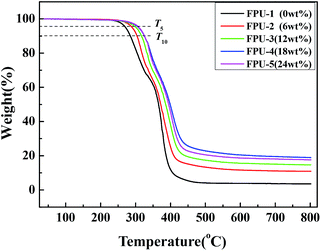 | ||
| Fig. 3 TGA curves of polyurethane with different dosage of LFH at a heating rate of 10 °C min−1 in N2. | ||
| No. | Polyurethane | T5/°C | T10/°C | Yc at 800 °C, % |
|---|---|---|---|---|
| 1 | FPU-1 | 267 | 285 | 4.0 |
| 2 | FPU-2 | 284 | 303 | 10.1 |
| 3 | FPU-3 | 295 | 315 | 14.2 |
| 4 | FPU-4 | 304 | 325 | 19.1 |
| 5 | FPU-5 | 305 | 325 | 17.3 |
Dynamic mechanical analysis
Thermo-mechanical properties of the obtained FPUs were studies by means of dynamic mechanical thermal analysis (DMTA) which allows different types of transitions and relaxations to be detected and related to the structure and morphology of the samples. Fig. 4(a) and (b) shows the storage modulus and the dissipation factor (tan![[thin space (1/6-em)]](https://www.rsc.org/images/entities/char_2009.gif) δ) of polyurethanes with different dosages of LFH. As shown in Fig. 3a, the storage modulus of all polyurethanes stay above 109 Pa between −125 and −80 °C, attributing to the lower temperature than the glass transition temperature (Tg) of flexible chain. So the chain could not freely move and the stress relaxation could not appear. Besides, the addition of soft segment containing fluorine (LFH) leads to an obvious increase in the storage modulus value between −125 and −25 °C, because the presence of fluorine atoms increased the number of hydrogen bonds and strengthened intermolecular interaction force in polyurethane. When the dosage of LFH is 18 wt%, the ratio of the hard segment related to the rigid of FPU did not decrease too much, the interaction between soft and hard segments reached the best points (status), which could explain why the storage modulus of FPU is highest.
δ) of polyurethanes with different dosages of LFH. As shown in Fig. 3a, the storage modulus of all polyurethanes stay above 109 Pa between −125 and −80 °C, attributing to the lower temperature than the glass transition temperature (Tg) of flexible chain. So the chain could not freely move and the stress relaxation could not appear. Besides, the addition of soft segment containing fluorine (LFH) leads to an obvious increase in the storage modulus value between −125 and −25 °C, because the presence of fluorine atoms increased the number of hydrogen bonds and strengthened intermolecular interaction force in polyurethane. When the dosage of LFH is 18 wt%, the ratio of the hard segment related to the rigid of FPU did not decrease too much, the interaction between soft and hard segments reached the best points (status), which could explain why the storage modulus of FPU is highest.
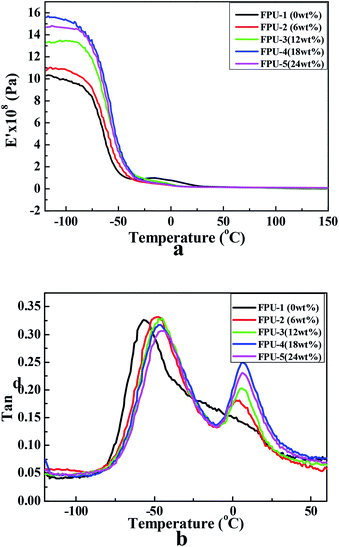 | ||
Fig. 4 Storage modulus (a) and the dissipation factor (tan![[thin space (1/6-em)]](https://www.rsc.org/images/entities/char_2009.gif) δ) (b) of fluorinated polyurethane with different dosage of LFH between −125 and 150 °C. δ) (b) of fluorinated polyurethane with different dosage of LFH between −125 and 150 °C. | ||
As shown in Fig. 4b, the curves of dissipation factor (tan![[thin space (1/6-em)]](https://www.rsc.org/images/entities/char_2009.gif) δ) apparently exhibited two peaks at low temperature (−80 to 0 °C) and at high temperature (0–50 °C), indicating that these five polyurethanes have two glass transition temperature (Tg). It may be caused by the microphase separation between the flexible soft segment and the rigid hard segment. With the increase of the ratio of the soft segment containing fluorine, the peak intensity at the high temperature also increased gradually, because Tg is susceptible to the introduction of soft segment containing fluorine with high molecular weight. The Tg of fluorine-free polyurethane in low temperature area is −56 °C, obviously, which is lower than fluorinated polyurethanes, indicating that the introduction of pendant group (–CF3) reduced the flexibility of the soft segment, the high electronegativity promoted the interaction between soft and hard segments. As a result, these fluorine-contained polyurethanes (FPU-2, FPU-3, FPU-4 and FPU-5) have higher thermal stability than the fluorine-free polyurethane (FPU-1). Furthermore, with the increase of fluorine content, the difference value between the Tg of hard and soft segments became smaller. At the same time, the microphase separation degree decreased, and the compatibility became better.
δ) apparently exhibited two peaks at low temperature (−80 to 0 °C) and at high temperature (0–50 °C), indicating that these five polyurethanes have two glass transition temperature (Tg). It may be caused by the microphase separation between the flexible soft segment and the rigid hard segment. With the increase of the ratio of the soft segment containing fluorine, the peak intensity at the high temperature also increased gradually, because Tg is susceptible to the introduction of soft segment containing fluorine with high molecular weight. The Tg of fluorine-free polyurethane in low temperature area is −56 °C, obviously, which is lower than fluorinated polyurethanes, indicating that the introduction of pendant group (–CF3) reduced the flexibility of the soft segment, the high electronegativity promoted the interaction between soft and hard segments. As a result, these fluorine-contained polyurethanes (FPU-2, FPU-3, FPU-4 and FPU-5) have higher thermal stability than the fluorine-free polyurethane (FPU-1). Furthermore, with the increase of fluorine content, the difference value between the Tg of hard and soft segments became smaller. At the same time, the microphase separation degree decreased, and the compatibility became better.
DSC analysis
Differential scanning calorimetry (DSC) technique is an important method to study the aggregative states and thermal transformation of polymer materials, it is necessary to study melting point (Tm) of FPUs. As shown in Fig. 5, with the temperature increasing, these FPUs show endothermic peaks at the rang of 150 °C to 200 °C. Melting range of each curve is long and the shape of each peak is not sharp, it attribute to the microphase separation structures of FPUs which are consistent with the DMTA findings (Fig. 4). Besides, with the dosage of LFH increase, Tm rise at the beginning and then decrease, and FPU-4 (18 wt%) have the highest Tm (177 °C). The main reason may be that the introduction of fluorine containing side groups would increase the number of the H⋯F hydrogen bonds, which would make ΔH larger. According to the formula: Tm = ΔH/ΔS, Tm grows.46 what is more, random copolymerization is another factor that make Tm larger. However, with the dosage of LFH increase, the reduction of hard segment ratio would make Tm reduce.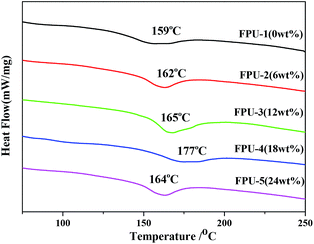 | ||
| Fig. 5 DSC curves of polyurethane with different dosage of LFH at a heating rate of 10 °C min−1 in N2. | ||
Conventional mechanic analysis at different temperature
Fig. 6 shows the tensile strength and elongation at break curves of fluorinated polyurethanes (FPUs) with different dosages of LFH (0 wt%, 6 wt%, 12 wt%, 18 wt%, and 24 wt%) at 25 °C, 100 °C, 200 °C and 300 °C, respectively. All the data are measured after FPUs being heated at each temperature for 40 min. Five measurements were made and the data were averaged. As shown in Fig. 6, at each temperature, both of tensile strength and elongation at break of FPUs increase as the dosage of soft segment containing fluorine increase at the beginning and then begin to decrease when the dosage of LFH increase to 18 wt%. At 25 °C, as the dosage of LFH increase to 18 wt%, polyurethane gains the best mechanical properties. The tensile strength is as high as 24.3 MPa, and the elongation at break is as high as 558.6%. Even in 300 °C, these two parameters still reached 17.8 MPa and 450.0%, respectively. At the same time, to evaluate the effect of dosage of LFH on the mechanical properties of FPU at different temperatures, ΔRm is defined as the value of decline of tensile strength from 25 °C to 300 °C. Obviously, ΔRm0 > ΔRm6 > ΔRm12 > ΔRm18 > ΔRm24, it shows a tendency of decrease with the increase of LFH dosage. The more of the fluoride soft segment content, the less decline of mechanical property. It is attributed to the great rigidity of the main chain of fluoro-carbon PTMG and the high polarity of fluoride groups. With the increase of the ratio of the fluoride group, the ratio of soft segment containing fluorine increased, meanwhile, cohesive energy of the F-MDI molecule in the micro area of hard segment increased, so the mechanical properties of FPU increased. However, with the increase of fluoro-containing soft segment, the ratio of hard segments which played the most important role in mechanical strength decrease. Therefore, when the ratio of the soft segment of fluoride increases to a critical value, the hard segment (BDO and MDI) plays the main role. As a result, there was a slight decline of tensile strength when the ratio of the soft segment of fluoride exceed the critical value. Considering the above mentioned factors, the mechanical properties exhibit a tendency of increase at the beginning and then decrease with the increase of the ratio of soft segment containing fluorine in polyurethane.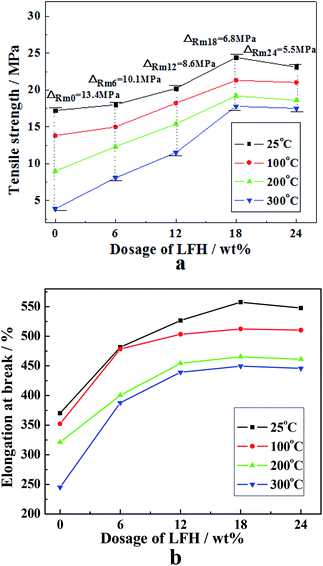 | ||
| Fig. 6 Tensile strength (a) and elongation at break (b) curves of fluorinated polyurethane with different dosage of LFH (0 wt%, 6 wt%, 12 wt%, 18 wt%, and 24 wt%) at different temperature. | ||
Water and oil repellency properties
In the field of aviation, jet aircraft oil is a traditional fuel. Fluoropolymer often be used as a material for sealing aircraft fuel tanks. Therefore, it is necessary to use jet aircraft oil for the oil repellency test. Water resistance is also an important indicator of fluoropolymer. In order to test the water and oil repellency of polyurethane after introducing LFH, FPUs films were immersed into water and jet aircraft oil at 25 °C for 22 days and 90 °C for 48 hours, respectively. The weight change is showed in Table 3. After FPUs films being immersed into water, the weight change of fluorine-free FPU (FPU-1) was 2.50% at 25 °C for 22 days, whereas with the dosage of LFH increasing, the weight change of FPUs decreased gradually. When the dosage of LFH increased to 24 wt%, the weight change of FPU-5 was only 1.79% at the same condition and 1.88% at 90 °C for 48 h. At the same time, when the media is jet aircraft oil, the weight change of fluorine-free FPU was 1.59% at 25 °C for 22 days and 1.69% at 90 °C for 48 h. And with the dosage of LFH increasing, the weight change of FPUs decreased to 0.76% at 25 °C for 22 d and 1.02% at 90 °C for 48 h. Obviously, the fluorine-containing soft segments could enhance the water and oil repellency of polyurethanes. Fluorine atoms have the characteristics of strong electronegativity, high C–F bond energy (540 kJ mol−1), short atomic radius and protecting fluorine-carbon chain through shielding effect. According to the classic wetting theory, with the ratio of fluorine-containing soft segment increasing, the surface energy of copolymer decreased, so the water and oil repellency of copolymer improved when the temperature below 100 °C.| Dosage of LFH | 0 wt% | 6 wt% | 12 wt% | 18 wt% | 24 wt% |
|---|---|---|---|---|---|
| Weight change/% (water, 25 °C, 22 d) | 2.50 | 2.13 | 1.95 | 1.81 | 1.79 |
| Weight change/% (water, 90 °C, 48 h) | 2.42 | 2.19 | 1.94 | 1.91 | 1.88 |
| Weight change/% (jet aircraft oil, 25 °C, 22 d) | 1.59 | 1.32 | 1.20 | 1.03 | 0.76 |
| Weight change/% (jet aircraft oil, 90 °C, 48 h) | 1.69 | 1.51 | 1.40 | 1.32 | 1.02 |
Fig. 7 showed the curve of tensile strength and elongation at break for samples after immerse into 90 °C water (a) and jet aircraft oil (b) for 48 h. Compared with the black curve which stands for the mechanical parameters of FPUs at room temperature in Fig. 6, the two parameters in Fig. 7 all decreased, which may be caused by the hydrolysis and corrosive action of ester groups and carbamates after immerse into hot solvent for a long time. In addition, the added fluorine soft segment enhanced the strength of hydrogen bonds, and hydrophobic fluorine atoms prevented the water molecular contact with groups that easily hydrolyzable in polyurethane, further improving its hydrolysis resistance. Comparing the Fig. 7a and b, it can be found that the tensile strengths of FPUs (FPU-3, FPU-4, FPU-5) immersed in jet aircraft oil at 90 °C for 48 h are higher than that of FPUs in water, it demonstrates that the oil resistance of FPUs is stronger than the water resistance of FPUs due to the sensitive hydrolysis of FPUs.
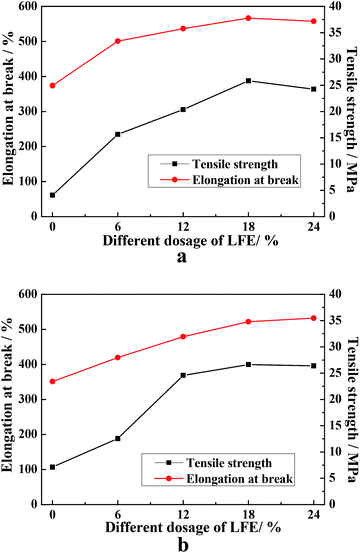 | ||
| Fig. 7 Tensile strength and elongation at break curves of fluorinated polyurethane films with different dosage of LFH in water (a) and jet aircraft oil (b) (90 °C, 48 h). | ||
Surface properties
Low surface energy and surface enrichment are two important characteristics of fluorinated polyurethane. Due to the migration of the fluorinated chain segments to the surface, the fluorine content in the surface of the material is enriched, so the fluorinated polyurethane has good hydrophobicity and lipophobicity.39 The static contact angle (CA) of FPU with different dosage of LFH were assessed by using the sessile drop method (Fig. 8). It can be found that the water CAs of the FPU films are 77°, 98°, 105°, 109 and 111° respectively, and the ethylene glycol CAs of the FPU films are 71°, 91°, 94°, 96° and 101° respectively. Obviously, as the dosage of LFH increase, both of the hydrophobicity and lipophobicity of FPU increase. What is more, with the increase of fluorine content, the surface energy of FPUs decreased rapidly. However, when the fluoride concentration reached a critical value, the change of membrane surface energy is very limited. This result demonstrates that only a small amount of fluorine-containing groups could highly change the surface properties of the polyurethane, which is very beneficial to reduce the cost of the product.Conclusion
In this paper, a series of fluorinated polyurethanes (FPUs) containing two polyester polyols as soft segment were synthesized via a two-step method. The two polyester polyols were hydroxy-terminated liquid fluorine elastomer (LFH) and polytetrahydrofuran glycol (PTMG). Meanwhile, dibutyltin dilaurate (DBTEL) is used as the catalyst. FTIR and GPC results indicated that fluorinated groups have been introduced into the structure of copolymer, and all the monomers were copolymerized successfully. Water and ethylene glycol CAs showed that the surface properties change little when the dosage of LFH is higher than 6 wt%. TGA, DMTA and conventional mechanic analysis showed that FPUs gained optimal thermal stability (thermal decomposition temperature of 304 °C, char yield at 800 °C of 19%) and mechanical property (tensile strength of 24.3 MPa) when the dosage of LFH increases to a critical value (18 wt%). Even after the cured films being immersed into hot water and oil, the FPUs also exhibit good mechanical property. This research could helps to achieve the balance between benefit and performance easily.Acknowledgements
This work was financially supported by International Cooperative Project (Harbin Institute of Technology 2014DFR40370 and Wuxi HIT Limited Corporation & Research Institute of New Materials BZ2015024).References
- C.-L. Wu, S.-H. Chiu, H.-T. Lee and M.-C. Suen, Polym. Adv. Technol., 2016, 27, 665–676 CrossRef CAS.
- T. Takakura, M. Kato and M. Yamabe, Macromol. Chem. Phys., 1990, 191(3), 625–632 CrossRef CAS.
- Z. Ge, X. Zhang, J. Dai, W. Li and Y. Luo, Eur. Polym. J., 2009, 45(2), 530–536 CrossRef CAS.
- E. Alyamac and M. D. Soucek, Prog. Org. Coat., 2011, 71, 213–224 CrossRef CAS.
- J. Ge, Y. Si, F. Fu, J. Wang, J. Yang, L. Cui, B. Ding, J. Yu and G. Sun, RSC Adv., 2013, 3, 2248–2255 RSC.
- M. S. Shin, Y. H. Lee, M. M. Rahman and H. D. Kim, Polymer, 2013, 54, 4873–4882 CrossRef CAS.
- J. Li, X. Zhang, Z. Liu, W. Li and J. Dai, J. Fluorine Chem., 2015, 175, 12–17 CrossRef CAS.
- B. Ou, M. Chen, R. Huang and H. Zhou, RSC Adv., 2016, 6, 47138–47144 RSC.
- J.-M. Park, Y.-H. Lee, H. Park and H.-D. Kim, J. Appl. Polym. Sci., 2014, 131, 40603 CrossRef.
- Z. Wang, Z. Hou and Y. Wang, J. Appl. Polym. Sci., 2013, 127, 710–716 CrossRef CAS.
- H.-W. Engels, H.-G. Pirkl, R. Albers, R. W. Albach, J. Krause, A. Hoffmann, H. Casselmann and J. Dormish, Angew. Chem., Int. Ed., 2013, 52, 9422–9441 CrossRef CAS PubMed.
- Y. Wang and Y. Bai, RSC Adv., 2016, 6, 53730–53748 RSC.
- A. Lovelace, British., 797795, 1958.
- J. Hollander, F. Trischiler and R. Gosnell, J. Polym. Sci., 1967, 5, 2757 CrossRef.
- T. Ho and K. Wynne, Macromolecules, 1992, 25, 3521 CrossRef CAS.
- C. Tonelli, G. Ajroldi, A. Turturro and A. Marigo, Polymer, 2001, 42, 5589 CrossRef CAS.
- C. Tonelli, G. Ajroldi, A. Turturro and A. Marigo, Polymer, 2001, 42, 9705 CrossRef CAS.
- C. Tonelli and G. Ajroldi, J. Appl. Polym. Sci., 2003, 87, 2279 CrossRef CAS.
- M. Bassi, C. Tonelli and A. Meo, Macromolecules, 2003, 36, 8015 CrossRef CAS.
- K. Chen and J. Kuo, Macromol. Chem. Phys., 2000, 202, 2676 CrossRef.
- L. Wang, Eur. Polym. J., 2005, 40, 293 CrossRef.
- L. Wang and Y. Wei, Colloids Surf., B, 2005, 402, 31 Search PubMed.
- H. Tan, X. Xie, J. Li, Y. Zhong and Q. Fu, Polymer, 2004, 45, 1495 CrossRef CAS.
- H. Tan, M. Guo, R. Du and X. Xie, Polymer, 2004, 45, 1647 CrossRef CAS.
- Y. Kim, J. Lee, Q. Ji and J. McGrath, Polymer, 2002, 43, 7161 CrossRef CAS.
- Y. Tang, J. Santerre, R. Labow and D. Taylor, J. Appl. Polym. Sci., 1996, 62, 1133 CrossRef CAS.
- H. Yeganeh and M. A. Shamekhi, Polymer, 2004, 45, 359–365 CrossRef CAS.
- P. I. Kordomenos, J. E. Kresta and K. C. Frisch, Macromolecules, 1987, 20, 2077–2083 CrossRef CAS.
- Y. Ma, Q.-Y. Tang, J. Zhu, L.-H. Wang and C. Yao, Chin. Chem. Lett., 2014, 25, 680–686 CrossRef CAS.
- A. Kausar, S. Zulfiqar and M. I. Sarwar, Polym. Degrad. Stab., 2013, 98, 368–376 CrossRef CAS.
- C.-e Yuan, M. Z. Rong and M. Q. Zhang, Polymer, 2014, 55, 1782–1791 CrossRef CAS.
- M. Xue, Y. Chen, Y. Si, Y. Li, H. Wan, J. Yu, G. Sun and B. Ding, RSC Adv., 2013, 3, 7562–7569 RSC.
- L. Zhang, Y. Li, J. Yu and B. Ding, RSC Adv., 2015, 5, 79807–79814 RSC.
- J. Sheng, M. Zhang, W. Luo, J. Yu and B. Ding, RSC Adv., 2016, 6, 29629–29637 RSC.
- J. Ge, Y. Si, F. Fu, J. Wang, J. Yang, L. Cui, B. Ding, J. Yu and G. Sun, RSC Adv., 2013, 3, 2248–2255 RSC.
- J. Li, Y. Lu, Y. Liu, Y. Li, W. You, C. Liu, L. Guo, X. Zhang and S. Qi, Polym.-Plast. Technol. Eng., 2014, 53, 46–53 CrossRef CAS.
- Z. Petrović, Z. Zavargo, J. Flyn and W. Macknight, J. Appl. Polym. Sci., 1994, 51, 1087–1095 CrossRef.
- Y. Zhang, S. Shang, X. Zhang, D. Wang and D. Hourston, J. Appl. Polym. Sci., 1996, 59, 1167–1171 CrossRef CAS.
- E. Discekici, A. Anastasaki, R. Kaminker, J. Willenbacher, N. Truong, C. Fleischmann, B. Oschmann, D. Lunn, J. Alaniz, T. Davis, C. Bates and C. Hawker, J. Am. Chem. Soc., 2017, 139, 5939–5945 CrossRef CAS PubMed.
- L. Li, Y. Li, Y. Lan and J. Zhang, Chin. J. Magn. Reson., 2007, 24, 353–364 CAS.
- C. Boyer, D. Valade, L. Sauguet, B. Ameduri and B. Boutevin, Macromolecules, 2005, 38, 10353–10362 CrossRef CAS.
- Y. Yuan, Chem. Propellants Polym. Mater., 2008, 6, 16–19 CAS.
- ASTM Standard D4665-87, 1987 Search PubMed.
- T. Fischer and R. Krueger, Plaste Kautsch., 1988, 35, 342–348 CAS.
- J. Xiong, F. Sun and H. Du, Chinese. J. Anal. Lab., 2007, 8, 73–76 Search PubMed.
- H. Zhou, J. Tang, J. Zhang and W. Guo, Guangdong Chemistry, 2014, 21, 232–233 Search PubMed.
| This journal is © The Royal Society of Chemistry 2017 |

